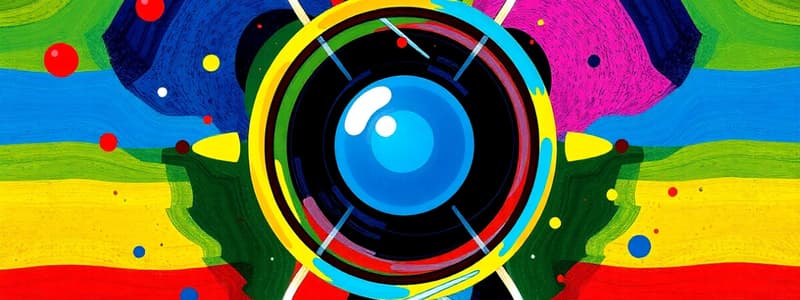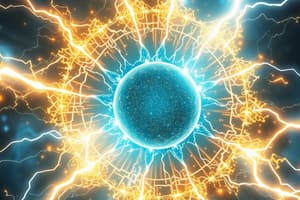Podcast
Questions and Answers
What happens when an atom becomes a positively charged ion?
What happens when an atom becomes a positively charged ion?
- It gains an electron from a nearby atom.
- It repels all other electrons.
- It loses an electron to a nearby atom. (correct)
- It causes an imbalance in electric current.
What is the term used for the flow of electrons towards a positively charged source?
What is the term used for the flow of electrons towards a positively charged source?
- Current Flow
- Electro-Motive Force
- Electron Flow (correct)
- Electron Drift
Which of the following is NOT an effect of electron flow?
Which of the following is NOT an effect of electron flow?
- Magnetic field generation
- Production of heat
- Physical movement of the atom (correct)
- Operation of electric motors
What defines the rate of electron flow in a circuit?
What defines the rate of electron flow in a circuit?
How many electrons are required to equal 1 volt?
How many electrons are required to equal 1 volt?
In what type of electricity do electrons move through a circuit and perform work?
In what type of electricity do electrons move through a circuit and perform work?
What is produced by an imbalance in electrical potential?
What is produced by an imbalance in electrical potential?
What occurs when two materials are rubbed together?
What occurs when two materials are rubbed together?
What drives the flow of electrons in a circuit?
What drives the flow of electrons in a circuit?
What is a characteristic of static electricity?
What is a characteristic of static electricity?
What is the primary function of a photocell?
What is the primary function of a photocell?
What determines the amount of electricity produced by electromagnetic induction?
What determines the amount of electricity produced by electromagnetic induction?
Which condition is NOT required to produce a voltage by magnetism?
Which condition is NOT required to produce a voltage by magnetism?
What is the main difference between wet cells and dry cells?
What is the main difference between wet cells and dry cells?
Which method can increase the rate of voltage production through electromagnetic induction?
Which method can increase the rate of voltage production through electromagnetic induction?
What happens to electrons when a conductor cuts across magnetic lines of force?
What happens to electrons when a conductor cuts across magnetic lines of force?
In which device is a wet cell commonly found?
In which device is a wet cell commonly found?
Which of the following statements about electromagnetic induction is true?
Which of the following statements about electromagnetic induction is true?
When a loop of wire spins in a magnetic field, what does it generate?
When a loop of wire spins in a magnetic field, what does it generate?
What is the role of charged ions in chemical action within cells?
What is the role of charged ions in chemical action within cells?
What occurs when an atom loses electrons?
What occurs when an atom loses electrons?
In which situation is static electricity most likely to become a concern?
In which situation is static electricity most likely to become a concern?
What phenomenon occurs when a quartz crystal is compressed?
What phenomenon occurs when a quartz crystal is compressed?
How does heat influence electron movement in copper?
How does heat influence electron movement in copper?
What happens to a metallic substance when it is exposed to light?
What happens to a metallic substance when it is exposed to light?
Which principle do thermocouples rely on?
Which principle do thermocouples rely on?
What type of charge is generated on a body when it gains electrons?
What type of charge is generated on a body when it gains electrons?
What causes a static charge to build up more readily?
What causes a static charge to build up more readily?
Which application uses the principle of the piezoelectric effect?
Which application uses the principle of the piezoelectric effect?
How does the surface charge of an aircraft change during movement in the air?
How does the surface charge of an aircraft change during movement in the air?
What is the role of valence electrons in the structure of an atom?
What is the role of valence electrons in the structure of an atom?
What happens to an atom when a positive charge is applied?
What happens to an atom when a positive charge is applied?
In an electric circuit, what does the term 'electron flow' refer to?
In an electric circuit, what does the term 'electron flow' refer to?
What do free electrons in a conductor represent?
What do free electrons in a conductor represent?
Why does the hydrogen atom have a neutral overall charge?
Why does the hydrogen atom have a neutral overall charge?
Which of the following methods does not generate electricity?
Which of the following methods does not generate electricity?
What occurs when electrons are displaced from their orbits?
What occurs when electrons are displaced from their orbits?
What characterizes a positively charged ion?
What characterizes a positively charged ion?
Which type of electron is most easily displaced from its orbit?
Which type of electron is most easily displaced from its orbit?
What type of electricity generation relies on pressure?
What type of electricity generation relies on pressure?
Flashcards are hidden until you start studying
Study Notes
Atomic Structure of Matter
- Atoms consist of a nucleus with electrons orbiting around it
- Hydrogen is the simplest atom, with one proton in its nucleus
- The number of electrons orbiting the nucleus always equals the number of protons in the nucleus
- Electrons in outer orbits are attracted to the nucleus by less force than electrons closer to the nucleus
- Outer electrons can be easily forced from their orbits, becoming free electrons
- Free electrons create an electric current.
Electron Theory
- When a positive charge is applied to an atom, the outer electron is drawn away.
- The atom now has more protons than electrons and is positively charged.
- Positively charged atoms attract electrons from surrounding atoms.
- The flow of electrons toward a positively charged source is called "electron flow."
- In a conductor connected to a source of electrons, the positive terminal attracts an electron.
- Electron movement happens within the conductor at the speed of light.
- An electron entering a conductor instantly forces another electron out from the other end.
- The flow of electrons performs work, such as powering lights, heating devices, electric motors, and electronics.
- An imbalance in electrical potential creates an electro-motive force (EMF), which is a driving force for electron flow.
Potential Difference
- One electron's potential difference is not practically useful.
- 6,250,000,000,000,000,000 electrons equal 1 volt.
- When a switch is turned on, electrons flow from one potential difference to another.
- The rate of electron flow is proportional to the potential difference.
Types of electricity
- Two main types of electricity are current and static electricity.
- Current electricity involves electrons moving through a circuit and performing work.
- Static electricity is more of a nuisance.
Voltage Produced by Friction
- When two materials are rubbed together, electrons are transferred from one material to the other.
- The material losing electrons becomes electrically positive, while the material gaining electrons becomes electrically negative.
- Good conductors equalize charges quickly, while poor conductors allow electrostatic charge to build up.
- Static charges are more readily created between non-conducting materials.
Voltage Produced by Pressure
- Compressing a quartz crystal creates charges on opposite surfaces.
- This phenomenon is known as the piezoelectric effect.
- The piezoelectric effect can convert mechanical energy into electrical energy.
- Microwaves and barbecue lighters utilize this principle.
Voltage Produced by Heat
- When copper is heated, valence electrons move towards the cooler end.
- In iron, electrons move towards the hotter end.
- Electron flow through the hot junction is proportionate to the intensity of heat.
- Thermocouples measure electron flow to indicate temperature.
Voltage Produced by Light
- Light has energy, similar to any moving force.
- Some metallic substances are sensitive to light.
- Light striking these surfaces dislodges valence electrons, creating a positive charge on the metal.
- The resulting EMF is known as photoelectric voltage.
Voltage Produced by Chemical Action
- Two dissimilar metallic materials immersed in a solution create a chemical reaction.
- One material has a greater chemical action, leading to the formation of charged ions and the production of EMF.
- Wet cells contain liquid electrolytes and must be kept upright.
- Dry cells have electrolytes mixed into a paste.
Voltage Produced by Magnetism and Motion
- To generate voltage through magnetism, three conditions must exist:
- A conductor where voltage will be produced
- A magnetic field near the conductor
- Relative motion between the field and conductor
- The conductor must move to cut through magnetic lines of force, or the magnetic field must move across the conductor.
- This motion forces electrons in a specific direction, creating electric force or voltage.
- Electromagnetic induction is the most common form of power generation.
- Aircraft generators and alternators, as well as atomic, hydro-electric, and fossil fuel power plants, utilize this principle.
Voltage Produced by Magnetism - Summary
- Spinning a loop of wire in a magnetic field creates EMF.
- Relative motion between the conductor and magnetic flux lines is essential.
Generation of Electricity
- Light, heat, friction, pressure, chemical action, and magnetism and motion are all methods to produce electricity.
Production of Electricity by Different Methods
- Friction: Rubbing materials together
- Pressure: Using the piezoelectric effect of materials (quartz)
- Heat: Heating materials with different responses to temperature changes
- Light: Using the photoelectric effect where light dislodges electrons from metals
- Chemical Action: Creating chemical reactions between dissimilar metals
- Magnetism and Motion: Using relative motion between a conductor and a magnetic field.
Studying That Suits You
Use AI to generate personalized quizzes and flashcards to suit your learning preferences.




